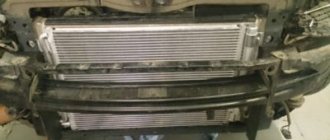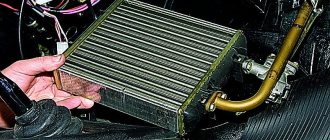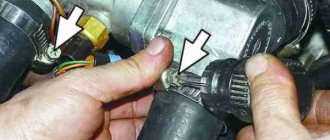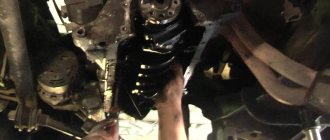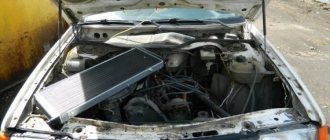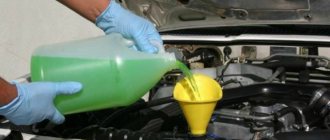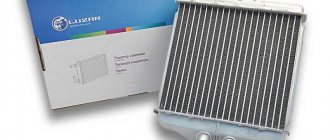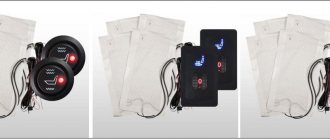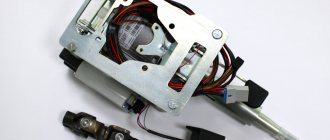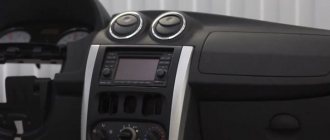Share
For owners of a popular crossover, the question of how to install an oil cooler on a Mitsubishi Outlander 3 CVT is far from idle. Overheating of the transmission sharply reduces the service life of the CVT , and on cars of the first years of production sold in Russia, the Japanese manufacturer did not provide a lubricant cooling system as standard, deciding to limit itself to supplying coolant to a small heat exchanger.
The result of this is an unacceptable increase in the temperature of the variator in various modes.
- When driving for a long time at high speeds. In this case, an unpleasant situation can be avoided by simply reducing the speed.
- When the vehicle is heavily loaded. It's not just a matter of a full cabin of passengers and a filled luggage compartment to capacity. The additional roof rack installed on the roof and the towed trailer also have an impact.
The fact that the temperature has risen above the permissible limit is indicated by a warning lamp that lights up on the instrument panel.
Why an additional radiator for a variator?
The CVT cooling radiator is designed to protect the automatic transmission from overheating. An increase in temperature above the permissible level leads to the following consequences:
- blocking the gear shift command;
- clutch damage;
- valve system wedge;
- hardening of gaskets/seals and inability to solve problems;
- the appearance of errors in the gearbox control unit, etc.
When driving in city conditions and with traffic jams, the working fluid can warm up to 110 °C at an outside temperature of no more than 20. If it gets even warmer outside, the heating of the oil also accelerates.
Installing an additional CVT radiator is aimed at preventing such consequences. The working fluid passing through it will be cooled, and the temperature will be maintained at a safe level - up to 80 °C.
In addition to cooling, you can achieve the following results:
- improve gearbox performance;
- ensure smooth running of the car;
- extend the service life of oil seals/hydraulic block;
- reduce the risk of future breakdowns.
Do you think installing an additional CVT radiator is important?
Yes, definitely!
75%
You can do without it
25%
Voted: 4
Rescue of drowning people is the work of the drowning people themselves
A significant number of complaints received from car owners prompted the company to install a cooling radiator on the Mitsubishi Outlander 3 CVT. New cars began to be equipped with them, and an extensive recall campaign was carried out for previously purchased ones.
Not all dealers fulfilled their responsibilities in good faith. In addition, the company installs the heat exchanger on new and already in operation crossovers according to a simplified scheme - without a thermostat accelerating the warm-up of the transmission. Car owners have to pay for these experiments. Therefore, information on how to install the Outlander 3 variator radiator with your own hands is very relevant.
Installing a radiator on a variator
Installing an additional CVT radiator requires preliminary preparation of the tool, purchasing equipment, performing a certain sequence of actions and testing.
To install such a part, you should know the principle of operation of the cooling system and have experience in performing such work. If you do not have the necessary knowledge, it is better not to take risks, but to entrust the installation to the Jatco service station technicians, who perform the installation in a short time and guarantee quality. Contact the “Center for work with CVTs No. 1”: Moscow 8 (495) 161-49-01, St. Petersburg 8 (812) 223-49-01. We accept calls from all regions.
Required parts and materials
No major modifications are required for modernization. You will have to spend money on purchasing the necessary components and consumables.
- Heat exchanger. Unlike the standard version, it must have not only pipes for supplying coolant, but also oil drainage channels. Finding a part on sale is not a serious problem. Its serial number is 2920A097. But it is not necessary to purchase the original. Buying an Italian analogue from Quattro Freni will cost half as much. The part from the CGA company from South Korea costs even less - about 3,200 rubles. O-ring No. 2920A096 is usually included in the kit. If not, you will have to purchase it separately.
- Oil cooler. It is acceptable to use a part from Mitsubishi Outlander XL . Its number is 2920A123. You can get by with an inexpensive analogue. For example, from the Czech company Zolert. In this case, installation on standard brackets and silent blocks is allowed. But the volume of such an oil cooler is small, and the cooling effect may be insufficient. It is more advisable to purchase a larger item. HAYDEN OC-1405 works well. It will ensure cooling of the variator under any load. But the fastening system will have to be thought out on site yourself.
- Thermostat. If you intend to install a larger oil cooler than the stock one, you will definitely need one. A good choice would be Mahle Original TO 9 75. You will have to select or make fittings for connecting the tubes.
- Radiator hoses. The standard kit has a number. Its purchase is completely justified, since the material must be oil resistant.
- Automatic transmission filter No. 2824A006 or a good equivalent. Once the heat exchanger is removed, it is easy to replace.
- Clamps (preferably screw), brackets (standard or made independently), bolts and clips in sufficient quantities.
- Antifreeze for topping up coolant and gearbox oil for topping up or completely replacing. Taking into account the volume of the oil cooler, its quantity should be 1.5 - 2.0 liters more than the quantity specified in the technical specification.
Try not to use cheap parts of questionable quality. They can cause damage, which should be avoided at all costs. Remember, the miser pays twice!
Breaking stereotypes: Mitsubishi Outlander CVTs
Fifteen years ago the history of the Mitsubishi Outlander crossover began. The process of evolution of the model led to the appearance in 2007 of the Outlander XL, equipped with a CVT transmission. Since then, “many copies have been broken” on this topic, as a result of which negative stereotypes about the CVT have given way to its recognition
Based on materials from Mitsubishi Motors
As already mentioned, the honorable mission of introducing a CVT within the framework of the Mitsubishi Motors Co production program was entrusted to the Outlander XL crossover, equipped with four-cylinder engines. A variator from the Japanese company Jatco with the index JF011E was used as an “intermediary” between the engine and the wheels, which is rightfully considered one of the most reliable transmission units of this type. It is not without reason that, in addition to Mitsubishi, it was installed on cars from Renault, Nissan, Citroen, Peugeot, Suzuki, Dodge, Jeep, etc. Such an extensive “customer list” contributed to the accumulation and systematization of reliable technical information related to this modification in particular and the use of CVTs in in general.
Owners of cars with a CVT enjoy the absence of shocks when switching, smooth acceleration and fairly low fuel consumption
As for the consumer reaction to this type of transmission in everyday use, everyone likes the absence of shocks when switching (since there are no such switches), which ensures unusually smooth acceleration, which is also accompanied by fairly low fuel consumption. On the other hand, people express dissatisfaction with the main problems of the variator: slow acceleration and noisy operation. Buyers are also frightened by the prospect of replacing this unit, because... in the official service it is changed as an assembly. And the cost of replacement is close to a third of the price of the car itself.
Much has already been said about the advantages of the variator and there is no point in repeating it. I would like to discuss some stereotypes... Let's start with slow acceleration . In fact, the car accelerates quite dynamically. If necessary, even much faster than the main thread. And the myth about the slowness of cars with a CVT was associated with the peculiarities of the functioning of this unit. The fact is that the degree of acceleration of the car depends on how hard the driver presses the gas pedal. Depending on this, the control unit selects the required rotation speed, and the engine operates monotonously at these speeds. Acceleration occurs with constant acceleration. When you press the accelerator harder, the speed increases accordingly. This differs from the usual algorithm of operation of a classic automatic transmission, when the speed and, accordingly, acceleration increase in each gear. Due to these peaks and dips in each gear, the feeling of “irrepressible” car dynamics is created. In cars with a manual transmission, these peaks and dips are even more noticeable, so our vestibular system perceives such cars as more temperamental. Cars with CVTs do not have alternating acceleration bursts, which is why people have formed the stereotype that the car “doesn’t drive.”
The second myth about CVT noise follows from the first . More precisely, from the algorithm of the variator operation - increasing speed at constant speeds. The peculiarity of the human ear is such that we begin to pay attention to the monotonous sound, which is precisely what is created by the engine during acceleration. Initially, the sound had “metallic notes”, and many took it for the noise of a variator. Moreover, the noise has an unpleasant timbre. In fact, this unpleasant monotonous hum of the power unit, causing discomfort to the occupants of the car, made its way into the cabin of the first Outlander with such a box due to poor sound insulation. The mentioned consumer complaints about cars with CVTs were the most common, and the manufacturer fought them.
The efforts of Mitsubishi Motors were not in vain. In 2012, when the third generation of Mitsubishi Outlander appeared, the operating algorithm of the remaining transmission was significantly changed. The engine speed began to increase as the car accelerated. And the gear ratio now changed much faster. The new settings not only helped to really improve the dynamics of acceleration, but also had a beneficial effect on the feeling of accelerating. As a result, criticism from consumers about the slowness and noise of a car with a CVT has decreased significantly.
In 2014, the Outlander underwent another update, as part of which Mitsubishi Motors once again rethought the CVT settings. Especially the response to the gas pedal. Combined with significantly improved sound insulation, this reduced the “customer negative” regarding the car’s dynamics to a minimum. And they stopped complaining about the noise of the variator altogether. By the way, in the same 2014, a variator cooling radiator was added to the car’s package, as some customers complained that when driving for a long time at high speed, a message about transmission overheating lit up on the car’s instrument panel, and therefore the electronics limited engine power. Owners of Outlanders who encountered this problem on earlier cars had the radiator installed free of charge, under warranty.
In 2015, the third generation Outlander was restyled, and the honored hard worker JF011E was retired. And the baton is taken up by the new eighth-generation Jatco CVT 8 variator with an increased power range in which the gear ratio can change. In addition, the design of the lubrication system in the new transmission unit has been improved, which has reduced transmission losses by as much as 26%. Once again, throttle response is minimized. A set of measures to modernize the variator made it possible to increase the acceleration dynamics of the crossover and its fuel efficiency. No matter what evil tongues say about CVTs, now not every driver will be able to distinguish the feel of a Mitsubishi Outlander with Jatco CVT 8 from its analogue with a nimble classic automatic transmission. And it's not surprising that the lightning-fast response to the gas pedal and the corresponding lack of delays during hard acceleration, characteristic of the latest generation of Mitsubishi crossovers, have reduced consumer complaints about throttle response to almost zero. And once again, improved sound insulation made it possible to completely forget about the loudness of the CVT in the past, and even made the Mitsubishi Outlander an exemplary “quiet” one in its class.
The variator belt is made of thin metal plates assembled together on multilayer metal belts
Another stereotype is associated with the supposed non-repairability of the variator. Indeed, if this unit fails during the warranty period, official dealers replace it entirely. The cost of the assembled variator is quite high. However, like other “assembled” units. However, it is worth considering that during the warranty period these costs are borne not by the client, but by the manufacturer. A complete replacement during the warranty period does not mean that the variator cannot be repaired in parts. If the car owner encounters a breakdown after the end of the warranty, the worn and faulty parts of the variator can be easily replaced individually. And the cost of repairs, including the cost of spare parts and labor, differs little from the same procedure for classic automatic transmissions. The bearings, cones, torque converter and solenoids, which are the main components of the CVT, are sold separately and are relatively easy to replace . The level of costs depends on what exactly has worn out or failed.
The variator of the Japanese company Jatco with the index JF011E is not unreasonably considered one of the most reliable units of this type
Often, the cost of “overhauling” a variator is lower than a similar operation for conventional automatic transmissions, which is not surprising, because a variator has fewer parts. With proper operation and timely oil changes, CVTs can easily operate for 200–300 thousand kilometers, which is quite comparable to the average performance of standard automatic transmissions.
In conclusion, we note that thanks to the improvement of CVTs, the number of cars with them is steadily growing. More and more automakers are including them in their production programs. The number of cars with CVTs in the model range is also expanding. And more and more people are becoming fans of cars with this type of transmission. This trend is clearly visible in the example of the Mitsubishi Outlander. All this is unconditional confirmation that the stereotypes associated with the CVT are almost broken.
The editors recommend:
Quiz!
Blackvue DVR for knowledge of traffic rules Alternative to a scraper: how to clean car windows without scratching them
Hyundai Elantra or Skoda Octavia: what to choose? We compared and were surprised
3 million is not a luxury: transport tax in Russia will be calculated in a new way
Which cars do dealers make the biggest markups on: list
Discussion Cancel
- Michael:
06/08/2021 at 12:09
Out 3 2.4 2013 I've already changed the oil in the variator 5 times, mileage 108t, so it hasn't died yet, moderate operation, overheating happens during long hauls on vacation at 130 km/h, I change the oil every 2 years myself, I buy a non-original one, I take an NS 3 Nissan (greenish ) or Totashi Korea (pink) to replace 5 liters flows clearly within 30 minutes by lifting the lion. I don’t change the front wheel filter at all because I can’t get to it.
Answer
- Oksana:
03/20/2021 at 06:03
Our car is 2015 Out. mileage 70,000, serviced, the variator was damaged, the interior cost 340t to replace the variator, the last service was in August, and six months later there was such a breakdown, they didn’t kill the car, you could say they licked it. Is it really that expensive?
Answer
- Serge:
01/31/2021 at 18:16
Merya has an Out XL, 2010, mileage 160,000, no problems with the variator. You can kill any box if you don't know how to drive.
Answer
- Novel:
06/09/2020 at 15:55
The first CVT on the Outlander XL 2013 was replaced under warranty for 55 thousand due to constant overheating. in a year. The replacement took place with threats of legal action, swearing, 3 videos were shot at speed with evidence of dates (newspapers, watches, telephone, etc.) for a long time and sadly. Before this, there was an epic battle for an additional cooling radiator. The second new variator with radiator heats up at 110 km/h in the summer, 130 in the winter. 100 thousand have passed. — breathes his last breath. The author of the article, like Bulgakov, “slightly lied.” This is a marketing hack, not a unit. Moreover, the officials recognize the problem and mold additional radiators into the kit of the next models, but this is a poultice for the dead.
Answer
- Ilya:
04/12/2020 at 13:51
Dear author! Your article looks like an advertisement for a CVT transmission. Of course, the Japanese company Jatco is a leader in the production of CVTs. But the reliability of these units is a thing of the past. If the Jatco variator with the index JF011E, as well as JF 010, were really reliable units and ran for 200 thousand km, and with good care, for 250 thousand km. The first type was installed on X trails and Outlanders until 2014. The second type on Murano and Tiana with 3.5-liter engines and a power of 249 hp. Modern Jatco CVTs with the index JF015E, JF016E, JF 017E rarely last even 100 km. mileage. And they are extremely unreliable! The modern trend towards creating disposable components and reducing the cost of production has done its job. And in most services, they very often refuse to repair them altogether (its price is from 130 to 180 thousand rubles). Buying a new variator is expensive 270-300 thousand rubles. You write in your article that more and more people give preference to a CVT transmission. You’re being disingenuous! Everything is happening exactly the opposite! This is precisely what explains the low cost of cars with a CVT on the secondary market. And why didn’t you write about the main thing! About the disadvantages of CVTs! And they are as follows: 1) Cars with a CVT cannot be loaded (you cannot gas hard and often, you cannot tow, you cannot slip). One slip may be enough to send you to a car service center.2) Cars with a CVT always need to be warmed up, especially in winter. After warming up the engine to operating temperature, it is not recommended to drive at high speeds for the first 3 kilometers.3) You should not drive on highways for a long time at engine operating mode is more than 4.5 thousand. As a result, the variator overheats. 4) Change the oil with filter every 30-35 thousand in a specialized service (not cheap). This is the real truth about the variator! Is it worth it? Personally, I , I think not. My father (a 68-year-old pensioner) took an Outlander with a CVT to drive to the dacha. Of course, he is not a racer. He treated it with care. He skidded slightly in front of me once. I tried to drive out carefully for just a minute, and then we went after the UAZ. Result: at 42 thousand km the variator began to malfunction. The car was sold. It was not even 5 years old.
Answer
- Alexei:
04/25/2020 at 11:04
Thank you for your objective assessment
Answer
- Alexander:
05/23/2020 at 11:39
I've already arrived for 160 thousand years, so far no complaints, I've been driving for 1000 km, nothing overheats. You wrote nonsense. A friend on a Suzuki Kizyash drove the same variator for 240 thousand. I never changed the oil and it only broke at 240, if I had changed it I would have driven it longer.
Answer
Yuri:
03/25/2021 at 01:17
This is 100% untrue; not a single CVT will travel 240 thousand without an oil change. Extremely unreliable, disgusting transmission. My father had an Outlander XL 2.4 and had problems with this transmission, despite the fact that he drives very calmly and the car is parked in an underground parking lot
Answer
Alexander:
04/21/2021 at 11:18
I don’t know how anyone drives, but I have a mileage of 137,000 km on a 2011 Outlander Xl. The variator works perfectly and does not overheat, although there were cases where it slipped and overloaded the car a little. Everything is fine. My next car will also have a CVT.
Answer
- Danya:
06/09/2020 at 19:44
I have an Outlander XL. Mileage 150 thousand km. There were problems only at the very beginning. At about 50 thousand on the Moscow - St. Petersburg highway, in the summer it popped up several times - transmission overheating. Slow down. And the car didn’t drive for some time. I stopped and cooled off. I was driving at a speed of about 130 km/h. I read on the forum that the fact is that these models do not have a radiator to cool the variator. And it is necessary to install it. I installed it on the service at my own expense. There were no more problems at the moment (150 thousand km).
Answer
- Vladimir:
03/07/2021 at 14:19
I had an X-Trail on an automatic, went through 350k, sold it and never got into a classic automatic. This is the mileage. And 160 is 10 years to the tape and back, perhaps. On 31X trails they fail at about 180k mileage +/- depending on how they were used.
Answer
- Sergey:
07/08/2020 at 17:53
Well, what the heck, I have a Qashqai 2.0, 12 years old, just with the 011 CVT, I took it with a mileage of 79,000 (I don’t know the driving style of the former owner, but there was a tow bar in the back), now it has 107,000, the wildest mockery on my part (starting from 3000 rpm, climbing through mud and snowdrifts with long and painful slipping, pulling other cars on a cable, long driving on the highway at a speed of 150-170 km/h, warming up in winter for no more than 15 minutes and then moving 500 meters at no more than 2000 rpm, then again I turn it up to 5-6 thousand.) True, I changed the oil at the time of purchase and at 105k (26k passed), no problems at all!!!!
Answer
- Valera:
10.20.2020 at 23:10
It’s interesting how on a CVT with 3000 rpm. will they move?
Answer
- Alexei:
10/29/2020 at 10:22 pm
“You can’t drive on highways for a long time with the engine operating at more than 4.5 thousand”
After that you don't have to read it. With a CVT, these speeds are reached at approximately 180-190 km/h. It is unlikely that anyone in their right mind would drive at such a speed for a long time... Yes, this is actually prohibited by the rules.
Answer
- Her:
02/02/2020 at 11:55
Anti-advertising☝️
Answer
- Andr:
01/31/2020 at 09:35
ADVERTISING! But in reality, everything is sad, breakdowns almost immediately after warranty, repairs are not really done in Krasnodar, at least, maintenance is expensive, oil is about 2 liters and you need 7 liters, plus rinsing, I got stuck with this miracle, it’s standing under the fence, I about cvt jf016e so think before you buy
Answer
